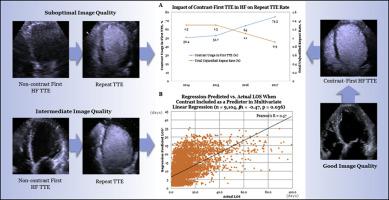Journal of the American Society of Echocardiography ( IF 5.4 ) Pub Date : 2021-07-18 , DOI: 10.1016/j.echo.2021.07.008 K Charlotte Lee 1 , Shizhen Liu 2 , Patrick Callahan 2 , Theresa Green 2 , Terika Jarrett 2 , J D Cochran 2 , Yajun Mei 3 , Sara Mobasseri 2 , Hassan Sayegh 2 , Vibhav Rangarajan 2 , Peter Flueckiger 2 , Mani A Vannan 2

|
Background
The authors retrospectively evaluated the impact of ultrasound enhancing agent (UEA) use in the first transthoracic echocardiographic (TTE) examination, regardless of baseline image quality, on the number of repeat TTEs and length of stay (LOS) during a heart failure (HF) admission.
Methods
There were 9,115 HF admissions associated with admission TTE examinations over a 4-year period (5,337 men; mean age, 67.6 ± 15.0 years). Patients were grouped into those who received UEAs (contrast group) in the first TTE study and those who did not (noncontrast group). Repeat TTE examinations were classified as justified if performed for concrete clinical indications during hospitalization.
Results
In the 9,115 admissions for HF (5,600 in the contrast group, 3,515 in the noncontrast group), 927 patients underwent repeat TTE studies (505 in the contrast group, 422 in the noncontrast group), which were considered justified in 823 patients. Of the 104 patients who underwent unjustified repeat TTE studies, 80 (76.7%) belonged to the noncontrast group and 24 to the contrast group. Also, UEA use increased from 50.4% in 2014 to 74.3%, and the rate of unjustified repeat studies decreased from 1.3% to 0.9%. The rates of unjustified repeat TTE imaging were 2.3% and 0.4% (in the noncontrast and contrast groups, respectively), and patients in the contrast group were less likely to undergo unjustified repeat examinations (odds ratio, 0.18; 95% CI, 0.12–0.29; P < .0001). The mean LOS was significantly lower in the contrast group (9.5 ± 10.5 vs 11.1 ± 13.7 days). The use of UEA in the first TTE study was also associated with reduced LOS (linear regression, β1 = −0.47, P = .036), with 20% lower odds for odds of prolonged (>6 days) LOS.
Conclusions
The routine use of UEA in the first TTE examination for HF irrespective of image quality is associated with reduced unjustified repeat TTE testing and may reduce LOS during an index HF admission.
中文翻译:

入院时常规使用对比剂经胸超声心动图治疗心力衰竭可降低入院期间重复超声心动图的发生率
背景
作者回顾性地评估了在第一次经胸超声心动图 (TTE) 检查中使用超声增强剂 (UEA) 对心力衰竭 (HF) 期间重复 TTE 次数和住院时间 (LOS) 的影响,无论基线图像质量如何录取。
方法
在 4 年的时间里,有 9,115 例 HF 入院与入院 TTE 检查相关(5,337 名男性;平均年龄,67.6 ± 15.0 岁)。患者被分为在第一次 TTE 研究中接受 UEA 的患者(对照组)和未接受 UEA 的患者(非对照组)。如果在住院期间进行了具体的临床适应症,则重复 TTE 检查被归类为合理的。
结果
在 9,115 名因 HF 入院的患者中(对比组 5,600 人,非对比组 3,515 人),927 名患者接受了重复 TTE 研究(对比组 505 名,非对比组 422 名),823 名患者被认为是合理的。在接受不合理重复 TTE 研究的 104 名患者中,80 名 (76.7%) 属于非对比组,24 名属于对比组。此外,UEA 使用率从 2014 年的 50.4% 增加到 74.3%,不合理重复研究的比率从 1.3% 下降到 0.9%。不合理重复 TTE 成像的比率分别为 2.3% 和 0.4%(分别在非对比组和对比组中),对比组中的患者接受不合理重复检查的可能性较小(优势比,0.18;95% CI,0.12– 0.29;P < .0001)。对比组的平均 LOS 显着降低(9.5 ± 10.5 天对 11.1 ± 13.7 天)。在第一研究TTE使用UEA的也与减少的LOS关联(线性回归,β 1 = -0.47,P = 0.036),具有较低的20%赔率为LOS的延长(> 6天)的赔率。
结论
无论图像质量如何,在第一次 HF 的 TTE 检查中常规使用 UEA 与减少不合理的重复 TTE 测试有关,并且可能会降低指数 HF 入院期间的 LOS。











































 京公网安备 11010802027423号
京公网安备 11010802027423号